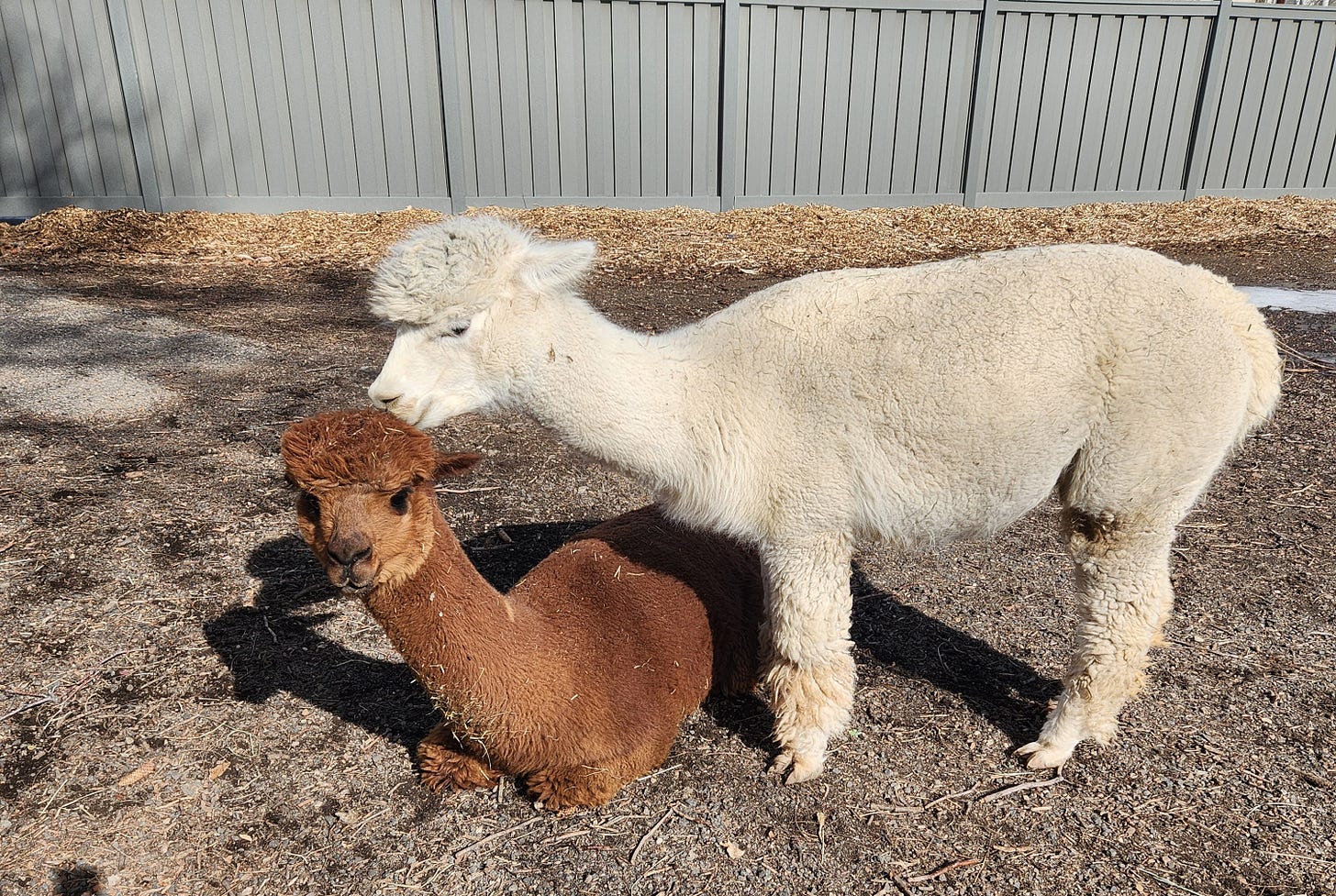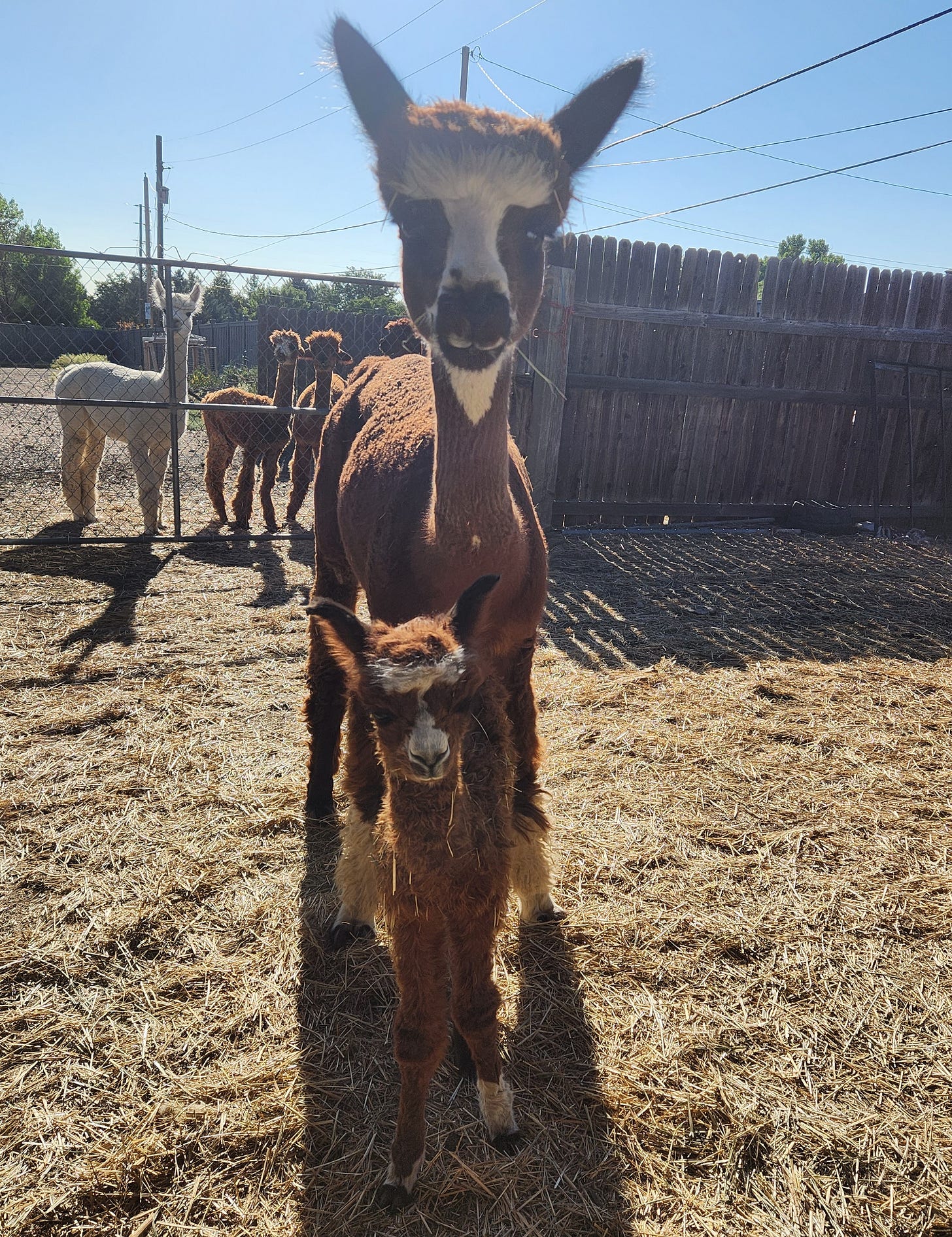This time last year, I wrote about one of our girls, Moira, who keeps trying to mount another alpaca, Clementine.
Miss Lonely Heart on the Alpaca Farm
I'll just start with the punchline. Moira keeps trying to mount Clementine.
Well, friends, she still does it and we are still a bit perplexed.
Are Alpacas Promiscuous?
I read once that alpacas are promiscuous. I don’t know if I would put it that way, but there’s a reason that most farms keep their male and female alpacas separate.1 Our mentor has, on more than one occasion, had a surprise pregnancy because a young male matured sexually sooner than expected and hadn’t been moved over with the big boys yet.
I vividly remember the day we visited our original four alpacas at their old home and practiced walking them on halters. When we passed the boys’ pasture all four girls craned their necks and pulled, eager to look at the fellas.
And, in an all-female herd, it is not unheard of for alpacas to mount each other. Are they hormonal? Is it a dominance move? Play? Or is it sexual? Honestly, it is hard to know. I asked Moira and Clementine, but they just looked at me, stunned by such a personal question.
I think that Moira mounting Clementine tracks her follicular cycle. I think she is eager to breed. I think that Clementine is too easygoing to bother fighting back anymore. But they could be lovers. I just don’t know. We plan to give Moira her wish and take her for a breeding visit again this year. I’m curious what happens after that. She tried to mount little Luna, who kicked her away. I was impressed.
How Alpacas Make Babies
Part of why male and female alpacas are typically kept separate is because they are pretty easy to impregnate. They become sexually mature between 18 months and two years old, and are not typically bred until they are two years old for females or 2.5 for males.
A female who wants to breed will cush for the male. Some ranchers help by moving her tail aside. A female who is not receptive or is already pregnant will spit at the male to go away.
Alpacas are induced ovulators. They have a follicular cycle in which follicles mature and regress, but copulation itself causes the egg to release. When they mate, male alpacas make a sound called orgling, which is believed to help trigger ovulation. This behavior is part of why alpacas are not bred through artificial insemination.
Here’s a video from Feighner Family Farms. Brace yourself:
Other Types of Alpaca Love
Alpacas are not animals who mate for life. Because alpacas are so often separated by sex, the majority of their lives are spent with their pals and I would argue that friendship is the most meaningful relationship they have.
Still, alpacas are often wonderful mothers. Their pregnancies last for 50 weeks on average and usually are single births. Get this, alpaca birth is called “unpacking.” The process is uncomplicated ~80% of the time, but sometimes the mother needs help, and having shoulder-length gloves on hand is a must. In rare cases, uterine torsion occurs, or the cria is breech, a potentially fatal complication for both dam and cria. In our experience the other alpacas are invested in the unpacking, sometimes more involved than the birthing dam would like. (I put a video down below.)
A dam and her cria hum back and forth to each other to sustain contact and bond. Nursing is important for the health of the cria, as they often have very weak immune systems at the start. That colostrum is essential. Our vet is vigilant about that because she has seen new farmers lose a cria in just a couple of days because nursing wasn’t going well and they didn’t notice. So, we have played lactation specialists before, but most girls get the hang of it quickly. Weaning typically occurs between 6-10 months.
Around 12-to-15 months of age, a young alpaca starts to develop independence, finding her place in the herd and forming friendships of her own. The other alpacas in the herd help socialize the young and too much human contact in the first six months can interfere with that process causing “Berserk Alpaca Syndrome,” which is rare but brilliantly named.
Alpacas have best friends! Female alpacas are particularly sensitive to each other and they show affection by tapping other alpacas with their noses in a gesture called bunting!
More on alpaca friendship here:
Next week, I will return with my February update from My Pronking Year—an exploration of local mushroom shops, growing mushrooms, and more.
Eleanor was born at night, which is atypical. Usually, crias come by lunch, so they can be dry and on their feet before nightfall (and predators). Theodora had an uncomplicated delivery, so we did not have to wake up the vet, but we stayed up to all hours to make sure the placenta came and nursing was initiated. You can see Nell trying to get to her feet here, with nosy aunties all over her. Unfortunately, she was born right in the mess from the haypile. That’s life.
Aside from general friskiness, male alpacas can also develop fighting teeth and can be rambunctious, so safety is also a concern. Sometimes females also develop fighting teeth. It’s rare but something to look for because they use fighting teeth to rip each other’s ears or ankle tendons. It’s not all cuteness and fluffiness!








Wow! I didn't expect to learn this much about alpaca reproduction today, but that was super interesting. I feel like "orgling" is going to make random appearances in my vocabulary from now on. 😂 And love the video with all the invested aunties. So cute!
“Orgling” is a fantastic word.